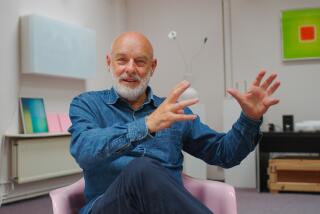Bassist/producer Holger Czukay of Can was one of the most influential musicians you may never have heard of
The bassist and composer Holger Czukay, whose death at 79 was announced Tuesday, played a key role in the creation of post-punk — before the term punk itself even existed and while much of Western youth culture was playing hippy-fied variations on electric blues.
As co-founder of the influential German experimental rock band Can, starting in 1968 the man with the horseshoe mustache and restless creativity expanded the range and role of the electric bass in rock music. Along with percussionist Jaki Liebezeit, Czukay was half of one of the most influential non-Beatles rhythm sections in rock music.
Music from the band’s albums, including “Monster Movie” (1969), “Ege Bamyasi” (1972) and “Future Days” (1973), has been sampled by artists including Kanye West, A Tribe Called Quest, Nine Inch Nails and Earl Sweatshirt.
Czukay is best known for his singular playing style, which spun looping, upper-octave runs where more traditional bassists like Paul McCartney, the Rolling Stones’ Bill Wyman or Stooges bassist Ron Asheton moved in lower register patterns.
Echoes of Czukay’s influence can be heard in the music of Public Image Ltd., the Buzzcocks, Joy Division, Stereolab, Interpol and LCD Soundsystem. A 1997 remix album, “Sacrilege,” featured reconfigured work by avowed fans Brian Eno, Sonic Youth, the Orb and Carl Craig.
Simultaneously, Czukay was a pioneer at integrating found-sound recordings with original works, zoning out onstage whether shirtless with electric bass or in the finest polyester and manipulating a reel-to-reel recorder.
Can, which he formed in Cologne with Liebezeit, keyboardist Irmin Schmidt, guitarist Michael Karoli and vocalist Malcolm Mooney, made its mark without ever achieving stateside success. Signed in America to United Artists, Can’s records were not only under-promoted but too out-there for commercial radio.
The band’s defacto leader, Czukay preached a kind of practiced spontaneity that he once described (in fractured English) as progressing like a sport.
In Can’s music, “you can’t really say in the next minute, where is that ball going to? It is a team which is playing with such a ball [that] knows very well about those strategies … But actually you can’t say, by definition, when is the ball in this or this area.”
Czukay continued: “We know how to build up the whole thing, but the actual sound and the actual development of the thing was not foreseen, and was something which was given to us by whatever powers — by spiritual or whatever that is.”
Textures were more important than classic AABA pop structures. Looping percussion mattered as much, if not more, than melodic progression. That approach resonated with with the punk community.
In Can’s best work you can hear the sound of an artist consumed with building something new and relentlessly pursuing the perfect mantra, the kind that gives you tingles as it carries you to some faraway place inaccessible but through meditative sound.
Achieving that feeling “made us encouraged, actually, to go on with rock music in general, instead of, let’s say, making avant-garde academic music,” he told rock historian Richie Unterberger in 1997.
“Academic music was somehow finished by the audiences, not by the musical idea itself,” he added. “We didn’t want to read music off papers. We really tried to make instant compositions from the very beginning.”
The band did this, said Czukay, “very much when we played live.” That’s an understatement.
That American audiences didn’t connect came as a surprise to him: “I thought the way the rhythms were done, the way how we played live, it was a hell, actually, of rhythmic impact.”
The band never toured America, but that rhythmic impact propelled both underground dance-floors and basement stoner sessions.
Asked about his influence, Czukay said he didn’t believe Can was as resonant as their peers in Kraftwerk. But, he added, when it comes to “making a party or a live evening, making a big performance of nothing, then Can can become very important.”
That’s because when Can was hitting the stage, he said, they were doing so “with an empty head, nothing pre-performed or nothing pre-whatever. We just went onstage, and who[ever] was throwing the first stone, we caught that and threw it back. And that was the beginning of the concert.”
Can ceased to be a fully functioning endeavor by the late 1970s, but Czukay continued to compose breathtaking works. His instrumental EP “Snakecharmer,” with U2 guitarist the Edge and former Public Image Ltd. bassist Jah Wobble, found three distinguished players working with atmospheric funk.
He dove into multi-track tape machines, approaching them as a new instrument to be mastered. Reveling in “the slow process of editing,” Czukay compared his research with multi-tracking to the cracking a code, this sort of “nuclear thing, this editing process. I thought it was like finding out something about the DNA code, and cloning and making artificial people,” he told interviewer Phil England in 1994.
Through his education with Karlheinz Stockhausen, Czukay had long explored the potential of magnetic tape and pre-recorded work — which later became known as sampling. His 1969 album as Technical Space Composer’s Crew (with Rolf Dammers), “Canaxis 5,” integrated old Folkways recordings and found-sound radio tapes with original music.
His oddball 1987 song “Hit Hit Flop Flop” is a pre-rave breakdown. Conversely, his more intimate, ambient, late-1980s works with British musician David Sylvian features atmospheric use of instruments including electric guitar, keyboards, harmonium and shortwave radio.
Czukay continued to work as if on a mission. In a recent interview with writer John Payne, said he was less interested than he used to be in meeting new people, preferring to focus on life with his longtime wife Ursula. (She recently died, as well.)
“The older you get the more you start to concentrate on yourself very much. That’s what I do,” he said. “No television, nothing. I don’t get enough sleep. We are working day and night. We don’t have a regular day and night rhythm with sleeping and not sleeping, but you get up and you continue.”
Referring to the minimalist composer, Czukay added, “It’s a bit like La Monte Young, you remember him? He started this idea to work over the clock, that means the day would have 25 hours. It’s quite clever.”
For tips, records, snapshots and stories on Los Angeles music culture, follow Randall Roberts on Twitter and Instagram: @liledit. Email: randall.roberts@latimes.com.
More to Read
The biggest entertainment stories
Get our big stories about Hollywood, film, television, music, arts, culture and more right in your inbox as soon as they publish.
You may occasionally receive promotional content from the Los Angeles Times.










